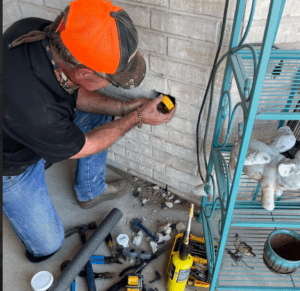A dripping faucet isn’t just a minor annoyance; it’s a clear sign of a plumbing issue that needs immediate attention. Ignoring the problem can lead to water wastage, higher bills, and potential damage to your plumbing system.
In this article, we explore 12 effective methods to help you stop a dripping faucet:
- Tightening the Faucet Handle
- Replacing the O-Ring
- Fixing a Loose Packing Nut
- Repairing a Faulty Valve Seat
- Cleaning the Aerator
- Adjusting the Water Pressure
- Lubricating the Stem
- Installing a New Cartridge
- Replacing the Ball Valve Assembly
- Upgrading to Ceramic Discs
- Fixing a Cracked Pipe
- Calling a Professional Plumber
These hacks range from simple DIY fixes to more complex solutions that may require professional tools or expertise. By applying these methods, you can save water, avoid the financial strain of hefty repair bills, and contribute to environmental conservation.
Are you curious about how you can tackle a leaking faucet with confidence? Each method outlined below is crafted to guide you through the process step-by-step. You might find that some are quite straightforward, while others might surprise you with their ingenuity.
For those who have tried all the tricks in the book and still face issues with persistent leaks, don’t hesitate to reach out to Expert Plumbers Round Rock Texas | 24/7 Plumbing Services for professional assistance in Round Rock and surrounding areas like Downtown Round Rock, Forest Creek Golf Club, Austin’s Park n’ Pizza, and even Pflugerville. Remember, acting swiftly can save you from the headache of larger repairs down the line.
Understanding the Impact of a Leaking Faucet
A dripping faucet might seem like a small nuisance, but it can lead to significant water wastage. In fact, you would be astonished by the volume of water that a leaky faucet can waste. A single drop per second from a drippy tap can waste about 3,000 gallons of water in a year. That is equivalent to enough water for over 180 showers!
Ignoring leaky faucets can also result in substantial financial burdens. The amount of money spent on wasted water could add up over time and be significantly higher than the cost of repairing a leaky faucet.
The environmental impact of faucet leaks should not be underestimated either. Freshwater is a critical resource, and its conservation is important for maintaining the ecological balance. Hence, preventing faucet leaks and stopping them promptly when they occur should be an integral part of our efforts towards sustainable living.
Don’t let your hard-earned money drip down the drain or contribute to unnecessary environmental harm because of a dripping faucet. Be it through detecting potential leaks early on, investing in energy-efficient appliances like tankless water heaters, or ensuring regular maintenance and repairs, every step you take towards water wastage prevention counts.
Moreover, it’s not just about addressing leaking faucets. Other plumbing issues like clogged drains can also have adverse effects on your household. So it’s crucial to tackle these problems promptly as well.
Remember, taking care of your plumbing system not only saves you money but also helps in conserving resources and protecting the environment. For instance, by fixing those pesky leaks, you’ll not only prevent water wastage but also avoid potential damage to your property, such as the foundation or even areas near important locations like the Dell Diamond.
12 Effective Methods to Stop a Dripping Faucet
A dripping faucet can be quite bothersome, but fear not, as there are effective methods to fix this issue. Here are twelve practical approaches that will help you bid farewell to those incessant drips and regain tranquility in your home.
Method 1: Replace the O-Ring
The O-ring serves as a seal between the spout and stem. If it’s worn out, replacing it can solve the problem:
- Turn off the water supply.
- Remove the handle of the faucet.
- Locate the O-ring, remove it, and replace it with a new one.
- Reassemble the faucet.
Method 2: Tighten the Packing Nut
The packing nut is usually located below or behind the handle. A loose packing nut can lead to leaks:
- Find the packing nut.
- Use an adjustable wrench to gently tighten it.
Method 3: Replace the Washer
Over time, washers can deteriorate and cause leaks:
- Shut off the water supply.
- Remove the handle and packing nut to expose the washer.
- Replace the old washer with a new one.
- Reassemble the faucet.
Method 4: Clean the Cartridge
Cartridges can get clogged with debris, affecting their performance:
- Turn off the water supply.
- Remove the handle to access the cartridge.
- Clean the cartridge using a vinegar solution and a toothbrush.
- Reinstall the cartridge and handle.
Method 5: Use Plumbing Tape
Leaking threads can be sealed effectively with plumbing tape:
- Thoroughly dry the area.
- Wrap plumbing tape tightly around the leaky section several times.
Method 6: Install a New Faucet Handle
Old handles often contribute to leaks:
- Remove the old handle.
- Follow the manufacturer’s instructions to install a new one.
Method 7: Apply Silicone Caulk
For temporary fixes on small leaks, silicone caulk can be helpful:
- Completely dry the leaky area.
- Apply caulk around the leak.
- Allow it to dry before turning on the water.
Method 8: Utilize Epoxy Putty
Epoxy putty is a quick fix for certain types of leaks:
- Cut the required amount of putty.
- Knead it until the color is uniform.
- Apply it to the leak and let it harden.
Method 9: Install a Faucet Drip Guard
Drip guards catch water from minor leaks:
- Follow the manufacturer’s instructions to install a drip guard.
Method 10: Use a Pipe Clamp
Pipe clamps can effectively stop leaks in pipes:
- Position the clamp over the leak in the pipe.
- Tighten it until secure.
Method 11: Adjust Water Pressure
High water pressure can cause faucets to leak:
- Locate your home’s pressure-reducing valve.
- Adjust it according to the manufacturer’s instructions.
Method 12: Seek Professional Help if Needed
Should all else fail, don’t hesitate to reach out to a professional plumber who possesses both the knowledge and tools necessary for faucet repair. They can also assess if there are underlying issues that require attention.
Conclusion
A leaking faucet is more than just a nuisance; it’s a call to action for water conservation and home maintenance. Ignoring it can lead to substantial water wastage and increased utility bills. You now have 12 proven methods to address this common household issue.
Apply these strategies and stop a leaking faucet in its tracks:
- Check for loose or worn-out parts
- Replace the faucet cartridge or valve stem
- Tighten the packing nut
- Fix a faulty washer
- Clean mineral deposits from the aerator
- Adjust the water pressure
- Replace the O-Ring
- Insulate exposed pipes
- Use pipe tape or thread sealant
- Install a faucet drip tray
- Secure loose pipes with cushioning materials or clamps
- Call a professional plumber if needed
Your proactive efforts can make a significant difference in solving the issue yourself or knowing when to seek expert help.
“Remember, if the problem persists or you’re unsure about tackling the repair yourself, seeking professional help is a wise choice.”
For those moments when you may need expert assistance, consider reaching out to Round Rock Plumbing for help with plumbing leaks or any other issues that might arise during your faucet repair journey.
It’s important to be aware of your rights and privacy when engaging with service providers, so take a moment to review their privacy policy.
By addressing dripping faucets promptly, you play a critical role in conserving water and ensuring the longevity of your home’s plumbing system. Don’t let another drop go to waste—take charge of your faucet repairs today!
Additionally, suppose you live in areas like Kalahari Resorts and Conventions or Champion Park, where plumbing issues can be more prevalent due to the scale of infrastructure. In that case, it’s even more crucial to address leaks promptly.
Key Takeaways:
- A dripping faucet is a common but significant issue that can waste water, increase utility bills, and potentially damage your home’s plumbing system.
- This guide provides 12 effective methods to fix a leaking faucet, ranging from simple DIY fixes to more complex solutions that may require professional help.
- Addressing leaks promptly not only conserves water but also prevents costly repairs and supports environmental sustainability.
FAQs (Frequently Asked Questions)
- What are the consequences of a leaking faucet?
A leaking faucet can lead to significant water wastage, resulting in higher water bills and environmental impact. It can also cause damage to the faucet and surrounding areas if left unattended. - How many effective methods to stop a dripping faucet are shared in this article?
This article shares 12 effective methods to stop a dripping faucet, providing readers with a variety of options to address the issue. - What is the financial and environmental impact of ignoring leaky faucets?
Ignoring leaky faucets can lead to increased water bills and contribute to environmental water wastage. It is important to address leaky faucets promptly to avoid these consequences. - What is Method 1 for stopping a dripping faucet?
Method 1 involves replacing the O-ring. The article provides detailed steps on how to successfully replace the O-ring to stop the faucet from dripping. - When should professional help be sought for fixing a leaking faucet?
If the methods provided in the article do not effectively stop the dripping faucet, or if there are underlying plumbing issues, it is advisable to seek professional assistance from a plumber. - Why is it important to take immediate action upon encountering a leaking faucet?
Taking immediate action upon encountering a leaking faucet is crucial for water conservation and maintenance purposes. Addressing the issue promptly can save water and prevent costly repairs.









